|
We
can not ship any horn or antler items on this page
outside the UK or to Northern
Ireland
If
you would like to purchase Stick Man Gift
Vouchers please click HERE
|
|
Please
note - small packages will normally be
sent by Royal Mail and larger ones by
courier.
|
|
We
can not ship any horn or antler items on this page
outside the UK or to Northern
Ireland.
|
|
|
Special
offer prices only apply when ordering
ONLINE
|
|
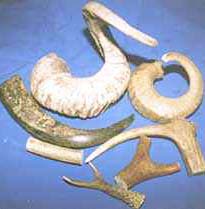
|
Horn and
Antler
It must be
appreciated that all horns and antlers are
naturally grown items and as such there may be
considerable variation between individual
pieces.
True horn is a
thermoplastic and can be heated, bent and shaped to
create wonderful horn handles, but you may need
specialist equipment to use it to its full
potential. Antler is bone and cannot normally be
bent.
If you require specific
sizes or shapes then please make sure you advise us
of these at the time of ordering - we do our best
to provide what our customers want but reading
minds is not our speciality!
As soon as you order anything your order form has a
box for "Additional order information" - please use
it to tell us what you want.
NOTE: Measurements
of horns are made along the outside
curve.
All countries have import
restrictions on "Animal Products" (which includes
'raw horns') to prevent the spread of infectious
diseases. All our horns are acquired legally and
have been disinfected where appropriate. However,
it has been our experience that horns and
unfinished horn products are very likely to be
stopped by Customs outside the EU.
We
can not ship any horn items on this page to
Northern Ireland.
|
|
|
|

|
Black Buffalo
Horn NEW
STOCK
from domesticated
Asian Water Buffalo
Solid tips - not hollow
like the ones from pet shops!
Although predominantly
black when polished, you will often find white
flecks or streaks, also smoky blues and greys will
appear in some horns. Polishes to a high gloss with
the use of metal polish on a cloth - or buy one of
our polishing kits (below) for that really
professional look.
|
|
|
|
|
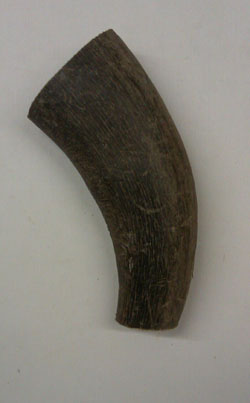
|
Buffalo horn
Hiker Blocks
Can be made into beautiful
polished Hiking Stick handles (or cut up for other
projects).
Sections of horns, roughly
an inch (25 mm) thick and 4 to 6 inches (10 - 15
mm) long, frequently with pronounced curve. No work
has been done so you can change the shape of the
raw horn to your own pattern if
desired.
|
|
We
can not ship any horn items on this page to
Northern Ireland.
|
|
|
|

|
How to bend Buffalo
Horn into crooks
Small home-made booklet by
The Stick Man. A detailed step-by-step guide
showing you the 'easy' way to make Buffalo Horn
handles. It includes colour photo's of a
horn-bending jig in use with tips on how best to
make use of it. Only £2.50
|
|
|
|
|
Pre-shaped
handles for walking sticks (still
require filing, sanding and
polishing).
Please note that
although these are made to "standard" patterns
there will inevitably be variations in exact
dimensions and coloration of horns. "Perfect"
pieces are rare - so don't expect them to be so.
Many horns will show some fine cracks or streaks of
grey, white, blue or brown and should not be
considered "faults". Personally I think the
perfectly black pieces look a bit too much like
plastic when polished.
|
|
We
can not ship any horn or antler items on this page
outside the UK.
|
|
|
|
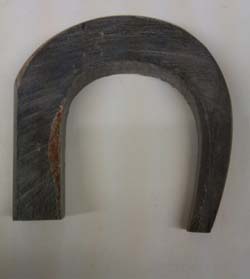
|
We
can not ship any horn items on this page to
Northern Ireland.
Buffalo
Horn Round Handle (long)
Long nose so you can turn
it outwards to make a full-turn nosed crook.
Roughly shaped for you to finish.
NEW
STOCK
|
|
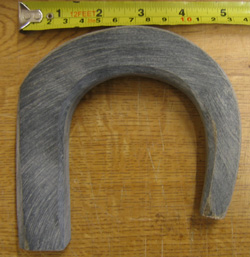
|
Buffalo Horn
Round Handle (short)
As above but with the nose
shorter and turned inwards. Roughly shaped for you
to finish. NEW
STOCK
|
|
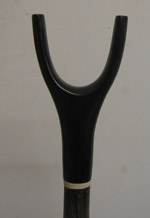
|
We
can not ship any horn items on this page to
Northern Ireland.
Buffalo Horn
Wide Fork Handle
Roughly shaped for you to
finish. NEW
STOCK
|
|
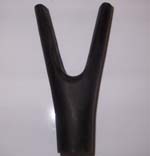
|
Buffalo Horn
Standard Fork Handle
Roughly shaped for you to
finish. NEW
STOCK
|
|
Rams
horn - this
is now almost impossible to get from abattoirs and
any I get from farmers quickly sell
out.
We
can not ship any horn items on this page to
Northern Ireland
|
|
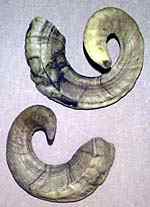
|
Please note that
some of the horns available still have bone cores
inside.
Prices vary
according to size (measured around the OUTSIDE
curve) and availability so, to make it easier to
order, I've put them into suitable categories for
stickmaking - but please note that exact size and
shape will vary due to differences in the horns
from different sheep breeds. I cannot guarantee
horns to be free from defects - though I do inspect
each one myself - and will only refund money if you
return them BEFORE you start to work on them! You
should, however, expect some horns to have small
cracks, splits, holes or hollows - all of these can
be 'worked' upon to produce a usable handle of some
kind but considerable skill is required and some
way of applying heat and pressure is needed to bend
and "bulk" the horn to get the best results.
Some horns are
easier to work than others but even experienced
stickmakers have failures! We can not guarantee any
horn will make a perfect stick.
HORNS ARE FROM
VARIOUS BREEDS OF SHEEP SO COLOURS CAN VARY FROM
PALE CREAM TO ALMOST BLACK.
If you want to
discuss your requirements prior to ordering we
welcome enquiries by email.
|
|
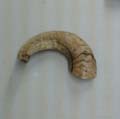
|
SMALL. (6 to 9"
long). Possible uses: small walking sticks, cut up
for other projects.
|
|
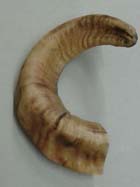
|
MEDIUM. (10 to 15"
long. Possible uses: market sticks, small crooks,
Cardigan sticks, Ramscurl sticks,
smaller carved crooks (thistle type),
half-heads and larger trout.
|
|
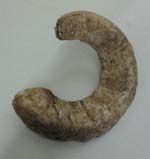
|
Large. (16" TO 19"
long ). Possible uses: Full sized crooks, carved
crooks, half-head sticks.
|
|
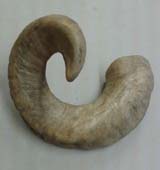
|
Extra Large (Over
20" long) Very heavy and bulky for carving birds
and animals on a crook. Some may have double
twists. VERY RARE - only a few left!
|
|
|
JACOB
HORNS
|
|
|
JACOB
HORNS
|
|
|
JACOB HORNS
|
|
|
Pair of horns
matched for size and shape. Colours
vary.
Not best suited to
stickmaking but useful for other craft projects
such as headresses, masks etc. where a nice
matching pair of horns is required.
|
|
|
CRAFT
GRADE
Damaged or VERY hollow horns, with cracks and
holes or other damage, making them less suitable
for stickmaking. Still useful for practising with
or decorative purposes and costume/mask making or
for cutting up for other projects. £4.00
each.
|
|
|
|
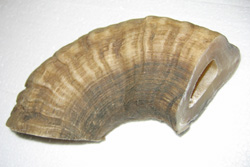
|
Rams Horn "Backs" -
hollow sections from the open ends of the horns
(may still have the bone core inside.) approx 3-6"
long. Useful for making horn spacers or capping
material. Can be cut, heated and shaped to form
ears, horns, beaks etc. on carvings. Also useful
for making spoons, napkin rings, shoe horns or
other craft projects.
|
|
We
can not ship any horn items on this page to
Northern Ireland.
|
|
|
Cow
Horn
NB due to BSE
regulations it is very difficult to get horns from
British cattle and importing them is complicated
and expensive now.
Most of our cow horns are
useful for making 'knob' type handles. These can
have coins, medals, badges etc. set in the open end
- or capped with horn or wood after filling the
hollow with wood, resin, car body filler or
similar. They are also bought for making masks and
head dresses.
Some of the medium and
large horns are from Longhorn and Highland breeds
and have enough solid material to be heated and
bent into handles - few will make crooks.
Cow horn has the unfortunate property of
'delaminating' while growing and a cross-section
cut will often reveal cracks or fissures which may
need to be heated and squeezed when making bent
handles (similar to 'bulking' ramshorn). Length
stated includes the hollow section where the
bone was. Most of these horns only have around 2 to
6 inches of solid horn at the tip - the rest is
hollow. Many of the smaller ones are hollow almost
to to the tip and may show signs of damage. If you
need to discuss specific purposes please
e
mail me before or
soon after ordering so we send what you are hoping
for.
The bigger ones can be
used for making powder horns, drinking vessels or
hunting horns.
For info on polishing horns or making drinking
horns go here
|
|

|
Cow Horns
British or European cow horns, 10-15" long for
knob handles or small market handles. Solid tips
around 3-6" plus hollow wider end.
LAST FEW
|
|
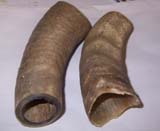
|
Cow Horn "Backs" -
sections from the open ends of the horns. Useful
for cutting up for capping material. Can be cut,
heated and shaped to form ears, horns, beaks etc.
on carvings. Also useful for making spoons, napkin
rings, shoe horns, drinking mugs or other craft
projects. Various sizes from around 50 mm to 100 mm
across open ends.
|
|
For abrasives
and tools for stickmaking
look
HERE
|
|
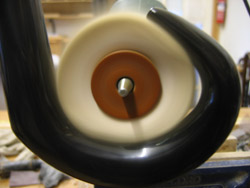
|
Polishing
Kit for
horn, antler, plastic and embedding resin.
Note: The polishing kit is best used after all
scratches have been removed with abrasive tape/mesh
and steel wool (see
Tools).
Set of two polishing
wheels, coarse and fine polishing compounds (one
for each wheel) and a threaded cone mandrel. The
mandrel fits almost any electric drill (including a
bench drill) converting it into a polisher! Use one
wheel with coarse compound to take out fine
scratches left after abrasives - then use the other
wheel with fine compound to polish to a bright
mirror-like shine!
Gently touch rotating wheel
with compound block to apply a fine
coating.
NB use eye
protection with rotating wheels and use on
fairly slow speed for best results. The wheels are
small enough to fit inside most crooks and
market sticks to get to those hard-to-reach
internal curves!
For replacement
compounds and additional polishing options see the
TOOLS
page.
|
|
|
 Read
about it
Read
about it
|

|
Stag
Antler
We
can not ship outside the UK.
|
|
|
British Stag Antler.
UNFORTUNATELY THE SUPPLY HAS VERY MUCH REDUCED DUE
TO THE BUYING-POWER OF THE PET INDUSTRY. ANTLERS
ARE BEING CUT UP AND SOLD AS DOG
CHEWS!
----------------------------------------------------------------------------
Exact
shapes vary
but will resemble pictures. Colour may vary from
near white to dark brown. Green staining may show
if naturally shed antlers have been left on grass
for some time. Thickness can vary a lot - from
under 20 mm to over 30 mm.
If you require specific
sizes/shapes/colours we will try to accommodate you
but you must let us know! It's a waste of our
time and yours if we post things out and then you
want to exchange them because they're not what you
wanted!
Most antler is oval in
cross section, making it awkward to fit to sticks
unless a spacer or collar is used - or you use
oval-topped sticks.
Some antler is quite smooth
to the touch, some is very rough. Most will have
some brown coloration which is usually
peat-staining from the hills where the stags live.
Antler is bone - not horn - so cannot be heated and
bent like true horn can be.
Old, naturally shed antlers (those that fall off in
the spring) can lose a lot of colour by becoming
bleached by sunlight. Often you will find one pale
side that's been exposed to sunlight and the other
side is darker where it's been shaded. Antlers from
culled stags are often very dark brown because
they've had no chance to bleach out the
colour.
It's quite feasible to
darken otherwise pale antler by staining or
painting
(Van Dyke Crystals on the SHANKS
page work well ). Whether pale or dark, I find it
best to sand down the surface to reveal some of the
paler bone underneath, giving a mottled or striped
effect. The paler areas polish extremely well,
particularly when buffing wheels are
used.
Antler has gone up in price
over the last few years because a lot of it is now
being sold for dog-chews in pet stores. Personally,
I won't give it to my own dogs because it can be
very hard and brittle and can break into very sharp
spiky pieces!
|
|

|
Antler Fork
Standard grade
for Thumbsticks.
Less regular in
shape than the grade A. Base of the "neck" often
more oval or narrow, requiring the use of a spacer
or collar to get a good joint with the shank - or
use up those oval-topped or thinner shanks you have
left after you've used all your best ones! These
are more variable in thickness and can go from 20
mm up to 35mm or (rarely) more. Please specify
if you have particular needs.
These are the
most popular antler pieces we sell and will make
very usable (and saleable) handles for working and
hiking sticks.
|
|
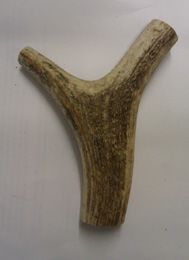
|
Antler Fork
grade "A"
for Thumbsticks.
Fairly regular in
shape and comfortable in the hand. Less "turn" in
the neck of the antler (so the fork is more
upright). More circular in cross section at the
base than the Standard grade antlers, making them
slightly easier to fit shanks to them.
Only a very small proportion of forks are grade "A"
so we can't always keep them in stock. These are
usually from the "top" ends of the antlers so are
mostly narrow at the bases - around 23 to 26mm.
Please specify if you have particular needs.
|
|

|
Antler Fork
Budget grade.
Irregular in
shape so less easy to fit shanks to them.
Can be used for cheap working sticks where
functionality is more important than classy looks.
Often used as dog chews too - but it's up to you.
|
|
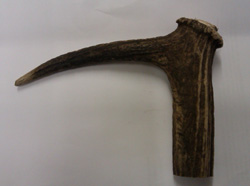
|
Antler Coronet
(Crown) Handle
Can be fixed to
shank "upright" or you can turn it on its side,
remove point and fix as a horizontal handle. The
horizontal handle will almost always require a
collar of some sort to enable a robust fixing to
strengthen the joint because the cut point is much
thinner. Various sizes available. Please specify if
you have particular needs.
|
|
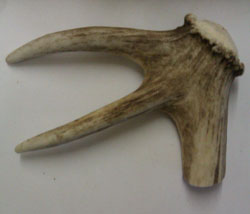
|
Antler Coronet
with Double Point
Coronet with two
points (tines) instead of one - you can make some
interesting and spectacular sticks with these. Not
all of these have equal length points, picture is
for illustration only.
|
|
|
Antler Roll
(Only thinner ones left at present)
Fairly straight
or slightly curved section of antler, 3" to 4" long
and around 3/4 to 1" thick. Use for an upright
handle grip for a hiking stick or small wading
staff. Top can be capped with horn and use a spacer
or collar at the bottom end to add length if
required.
|
|
|
Antler
Tri-Point
Section from the
tip of an antler where three points have grown
instead of two. These can make interesting and
unusual thumbsticks as no two are exactly alike.
Personally, I prefer to take the tips of the points
off and cap with horn (for safety reasons) but we
generally leave them on for you if they are not
excessively long. As these are from the very tips
of the antlers the bases are usually fairly thin -
around 23-26mm.
|
|
Horn
and bone spacers
We
can not ship any horn or antler items on this page
outside the UK.
|
|
|
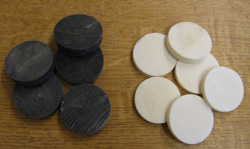
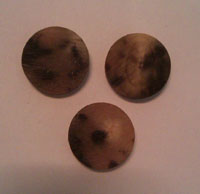
Buffalo horn (black or dark
brown with pale streaks). Cow horn (pale honey
coloured, sometimes with darker mottling) or
white/cream bone slices for capping stag horn or as
spacers between joints. These can be sawn, filed
and sanded to shape and polished or varnished.
Normal thickness is around 5 to 7 mm.
Sorry, but we don't drill
the spacers for you.
Note:
When drilling spacers make sure you support them on
scrap wood in the vice otherwise you will
invariable crack some of them! I find it best to
drill half way through from each side - especially
with the bone ones.
|
|
|
|
|

|
Horn/antler/bone off
cuts
For cutting into caps for
antler handles and various craft purposes.
Assortment of horn, bone & antler slices and
off cuts depending on what we have in stock,
approximately 150 gms in each pack.
|
|
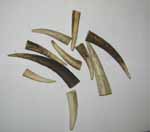
|
Antler points - Pack
of ten small points (1" to 3" long) for
making key rings, light pulls, zip pulls or small
whistles. £ 6.00
|
|
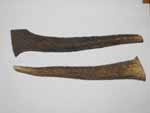
|
Pack of two large antler
points (3" to 6" long) for larger whistles,
knife handles etc.
|
|
|
Extra Large Antler point
(approx. 6" to 10" long and usually curved) for
knife handles etc.
|
|
|
Antler
collars
Roughly cylindrical
sections of antler with most of the core drilled
out. You may need to file and sand the collars to
get the best fit for your own sticks.
|
|
Roe
Buck antlers
|
|
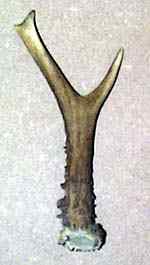
|
|
|
|
 Read
about it
Read
about it
|

|
|
|
|
|
|
|
See DIY
sticks question/answer page
|
|
|
DISCOUNT CODE
|